Teaching voluntary behaviors such as a chin rest can be useful when you want your dog to hold still and show you they are comfortable. A chin rest shows that your dog is willing to be an active participant in their care. Teaching a chin rest can be part of a dog's behavior modification plan when they are resistant to needed care, such as applying eye drops and ear medication. This is sometimes called cooperative veterinary care.
Dog Resting Chin on Towel

Photo courtesy of Pat Koven, LVT, KPA-CTP
Your dog can learn to target a chin rest to your palm as a stationary position, on a walk, target on a towel, or the arm of a wheelchair for petting in therapy work.
Dog resting chin on open hand
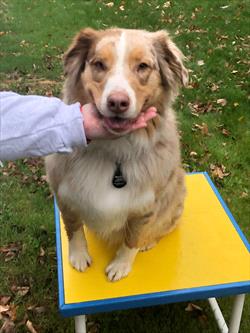
To prepare for training have high-value soft treats, and identify a comfortable height and position for both animal and trainer, such as a rolled up towel on a chair. When teaching this behavior, it is important to keep your hands steady, so your dog is not nervous.
Step 1: Stationary Chin Rest
Stationary chin rest
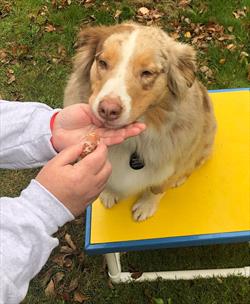
- Hold your open hand, palm up in front of your dog’s snout slightly below chin level.
- In your other hand, hold a treat in front of your dog’s face just below the nose beyond your “palm (target)” hand. As your dog reaches for the treat, lower your hand holding the treat to just below your open palm.
- As your dog rests their chin across your open palm mark the behavior and give them the treat.
- Repeat 3-5 times. This is the time to start adding the verbal cue “chin” as your dog’s rests their chin on your palm.
- Now test this behavior by offering your open palm just below the chin level and give the cue.
With their chin on your palm, begin adding duration by counting to 1 second then reward. Then begin rewarding at random times such as 3 seconds, then 2 seconds, then 4 seconds, so your dog does not learn a pattern.
A mark is a word or clicker that signals to your dog they have demonstrated the desired behavior.
Some tips to try:
Encouraging dog to lean chin forward
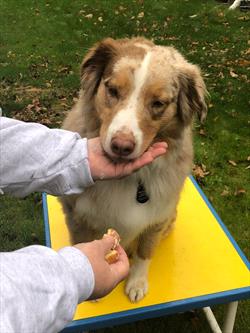
- To encourage the dog to lean forward to put their chin onto the target palm, hold the treat hand farther away from the palm hand on the same level so the dog sees the treat.
- To encourage your dog to lower their chin onto the target palm, bring the treat hand from below the target palm so your dog leans over the target palm and lowers their head to reach down toward the treat.
- Hold your palm hand at a height so your dog is not struggling to rest their chin on your open palm.
Step 2: Transfer the Behavior to a Towel or Object
- Roll up a small towel or use a pillow placed on the edge of a chair or table. It should be at a height comfortable for your dog to rest their chin.
- Place your hand, palm facing up, on the object upon which you want your dog to place their chin.
- Give the verbal cue “chin,” mark and reward each time your dog places their chin onto your open palm.
- Repeat this 3-5 times.
- To encourage your dog to rest their chin on a towel offer your open palm behind the object. Mark and reward your dog for resting their chin on the towel.
- Add duration slowly and variably as outlined above.
Dog resting chin on towel on chair
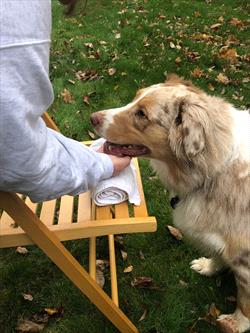
Photo courtesy of Pat Koven, LVT, KPA-CTP
Some tips to try:
Holding treat so dog drops chin
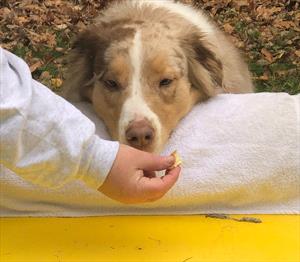
- To prompt the chin to drop into place, offer the treat below the level of the towel. Mark and reward. You may need to repeat this until your dog no longer requires prompting.
- You may need to raise or lower the height of the towel to make a chin rest more accessible.